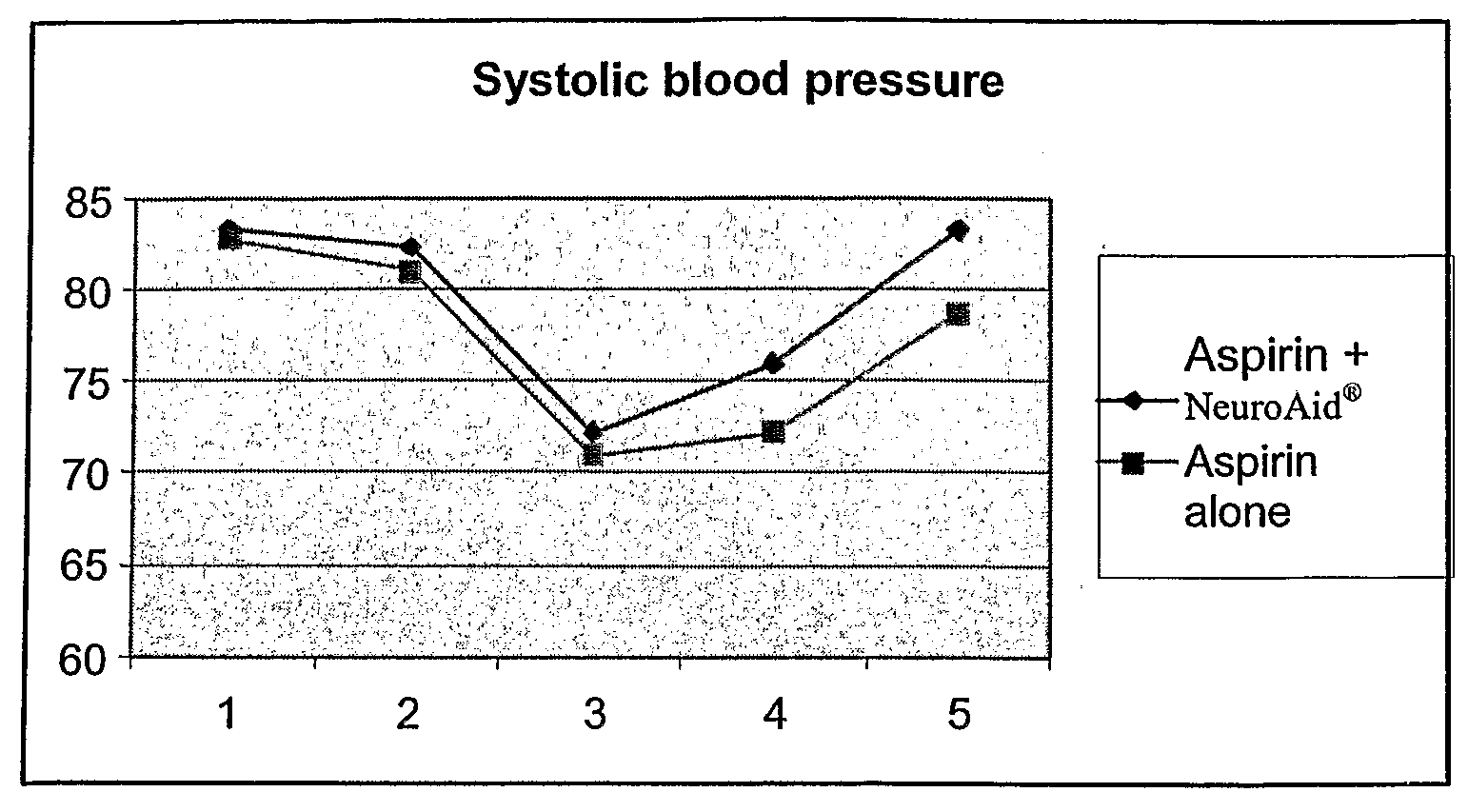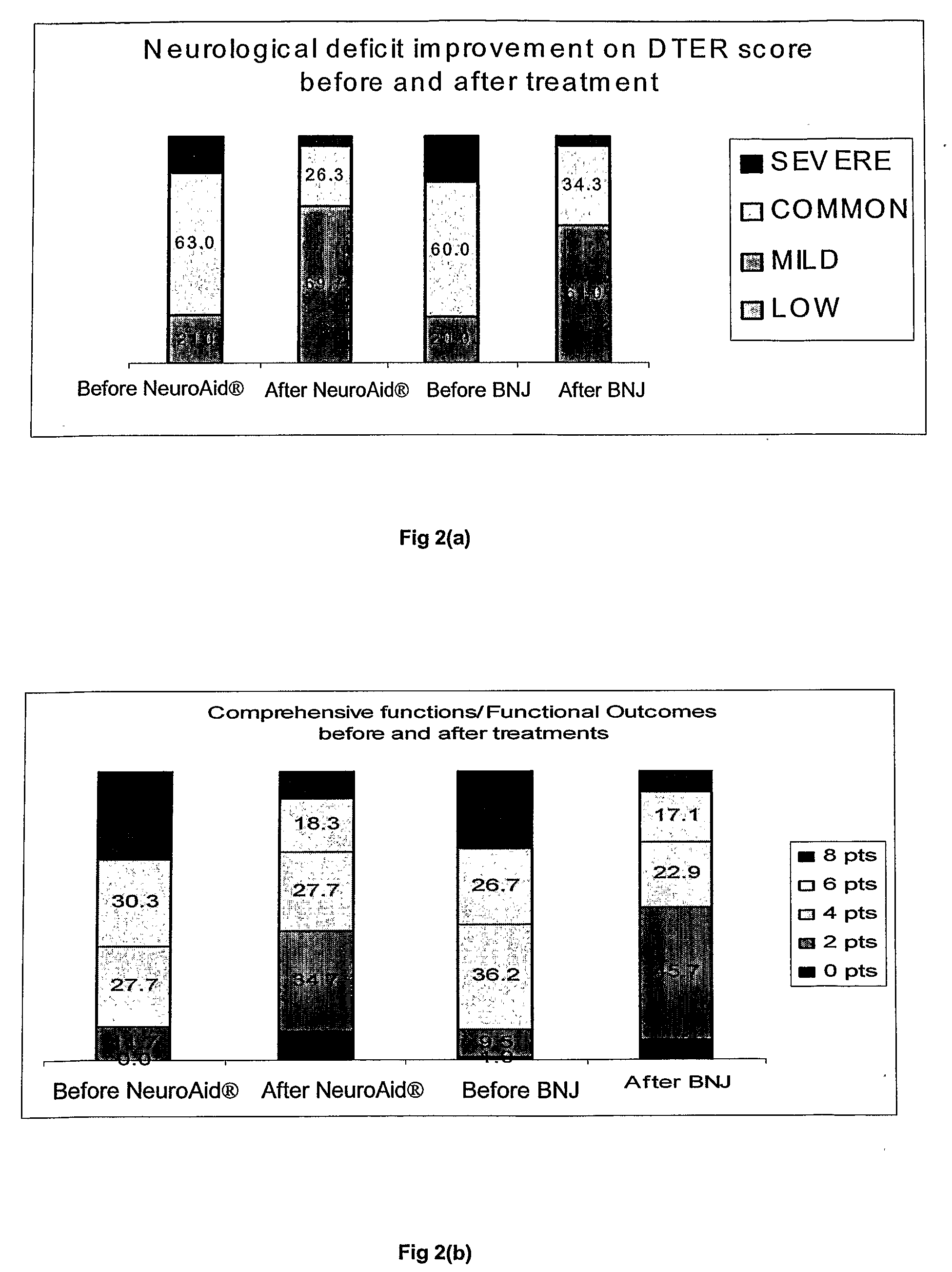Combination Therapy for Treatment of Patients with Neurological Disorders and Cerebral Infarction
a combination therapy and neurological disorder technology, applied in the direction of drug compositions, biocide, cardiovascular disorders, etc., can solve the problems of lack of treatment methods for stroke recovery, death and disability, and the use of tcm is, however, particularly challenging for european clinicians, so as to reduce bleeding and reduce the risk of ulcer development and bleeding
- Summary
- Abstract
- Description
- Claims
- Application Information
AI Technical Summary
Benefits of technology
Problems solved by technology
Method used
Image
Examples
example 1
Phase II Trial
NeuroAid® Versus Buchang Naoxintong Jioanang (BNJ)
[0059]A randomized, double-blinded, stratified, control design was adopted for the clinical trial on the efficacy of NeuroAid® in treating patients suffering from apoplexy compared to BNJ which is known for its effectiveness in treating patients suffering from apoplexy (see Example 3). A total of 200 subjects were involved; 100 cases were treated with NeuroAid® while 100 cases were treated with BNJ (control). BNJ is produced and provided by Xianyang Buchang Pharmaceutical Co., Ltd. Four capsules of each drug were administered 3 times daily, with each course of treatment lasting 4 weeks.
[0060]The evaluation criteria for neurological and functional recovery from apoplexy (DTER scoring diagnostic standard) and TCM symptom therapeutic effects (TCM diagnostic symptom scoring standard) were assessed in accordance with the Clinical Guiding Principles for the Treatment of Apoplexy with New Chinese Herbs promulgated by the Minis...
example 2
Phase III Trial
NeuroAid® Versus BNJ
[0062]A randomized, double-blinded, stratified, control design was adopted. A total of 405 subjects were involved, where 300 cases were treated NeuroAid® while 105 cases were treated with the control drug BNJ produced and provided by Xianyang Buchang Pharmaceutical Co., Ltd. Four capsules of each drug were administered 3 times daily, with each course of treatment lasting 4 weeks.
[0063]The evaluation criteria for neurological and functional recovery from apoplexy (DTER scoring diagnostic standard) and TCM symptom therapeutic effects (TCM diagnostic symptom scoring standard) were assessed as in the Phase II trial.
[0064]The data (FIG. 2) demonstrated that NeuroAid® was superior to BNJ in improving the patients' neurological deficit particularly in helping patients recover from their hemi-paralysis. With regard to functional outcomes, even if NeuroAid® failed to demonstrate any superiority to BNJ, both treatments had comparable effect and about 50% of ...
example 3
Comparative Study on Efficacy of BNJ Versus Citicoline and Aspirin
[0066]A randomized, double-blinded, stratified, control design was adopted for the comparative study on the efficacy of BNJ and Citicoline in treating patients with apoplexy. Citicoline is the only putative neuro-protectant that has shown results in Western randomized, double-blinded trials given within 24 hours after symptom onset. Davalos et al. (Oral Citicoline in Acute Ischemic Stroke. An Individual Patient Data Pooling Analysis of Clinical Trials (2002) Stroke 33:2850) documents the ability of Citicoline to improve complete recovery at 3 months.
[0067]A first comparative study performed in the PRC involved 150 subjects treated with Citicoline (0.5 g IV) for 15 days in combination with a TCM (Xueshuantong) and 160 subjects treated with Citicoline (0.5 g IV) for 15 days in combination with Xueshuantong and BNJ. The latter group treated with BNJ showed improvements in scores on a neuro-functional defects scale, plasm...
PUM
 Login to View More
Login to View More Abstract
Description
Claims
Application Information
 Login to View More
Login to View More - R&D
- Intellectual Property
- Life Sciences
- Materials
- Tech Scout
- Unparalleled Data Quality
- Higher Quality Content
- 60% Fewer Hallucinations
Browse by: Latest US Patents, China's latest patents, Technical Efficacy Thesaurus, Application Domain, Technology Topic, Popular Technical Reports.
© 2025 PatSnap. All rights reserved.Legal|Privacy policy|Modern Slavery Act Transparency Statement|Sitemap|About US| Contact US: help@patsnap.com



